Last Updated: 7 months ago
I was worried that our little cat, Booger, would topple off his cat tree.
After a few days, I wondered how to make a cat tree more stable.
I want to help you with what I learned, so I created this guide to ensuring you have a sturdy tree.
Let’s get started.
How to Identify if The Tree is Shaky
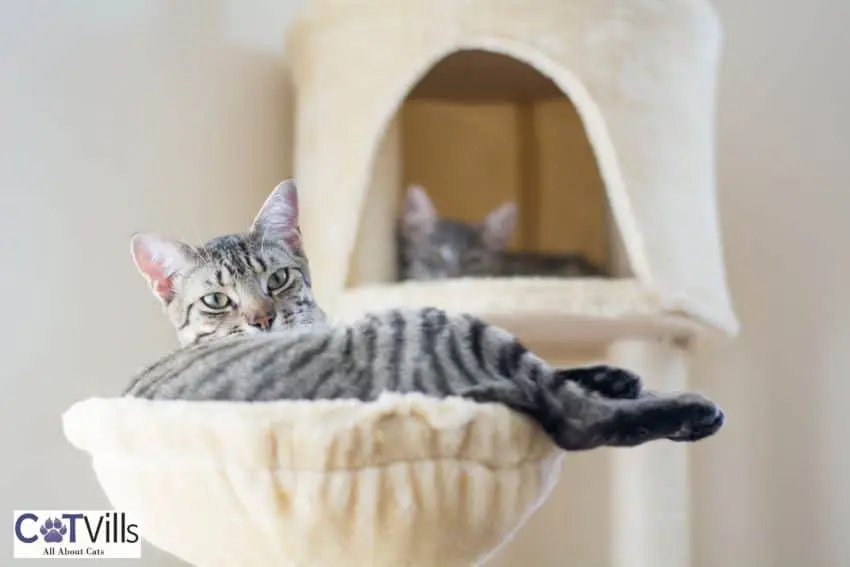
You have bought a new cat tree and placed it in a suitable space. However, you note that your cat has stopped playing around the tree after its first attempt.
Your first instinct is to put it away, but why not check its condition before doing that? If the tree is wobbly, that is the answer to why your cat is avoiding it.
Does stability matter in a cat tree? The answer is yes. A fall from a higher height can give your cat a traumatic experience.
To identify whether your tree is unsafe, start by examining the entire structure. Look for any signs of loose joints and screws.
The next step is to check the branches. The presence of one unstable branch can also make your cat avoid the tree or any future tall cat tree you get for them.
You can identify a wobbly cat tree by lightly shaking the post or branches with your hands to check for firmness. In this way, you will quickly identify any loose parts.
Are Cat Trees Supposed to Wobble?
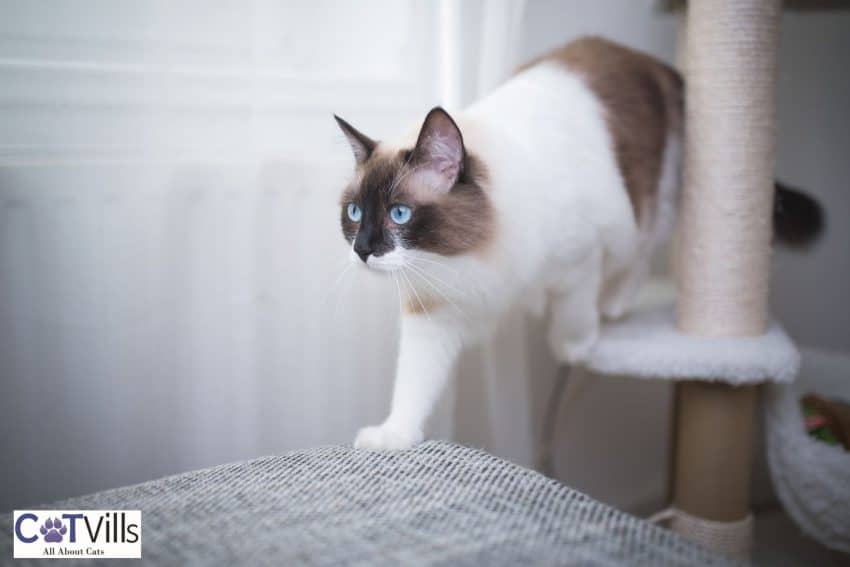
The answer is no. Cats are typically playful by nature, and there is a chance they are jumping across the room to their tree.
Their excitement dies down if the destination they expect to perch on topples over. This occurrence causes a negative association with cat trees.
It is no shock to find your cat uninterested in playing with any tree after experiencing a shaky one.
An unstable tree also puts your cat at risk of physical injury.
According to ASPCA Pet Health Insurance, falls can cause significant health issues like:
- Spinal fractures
- Shattered bones
- Fractured teeth/jaw
- Ruptured bladder
So, if you notice your tree is wobbly, let’s look at how to make cat tree more stable.
7 Steps to Stabilize a Wobbly Cat Tree
A cat tree offers an easy DIY challenge if you like experimenting with things. With a few tools, you are ready to give your cat a fantastic playtime experience.
Here is a step-by-step guide you can follow for how to fix a wobbly cat tree:
1. Gather the Necessary Tools
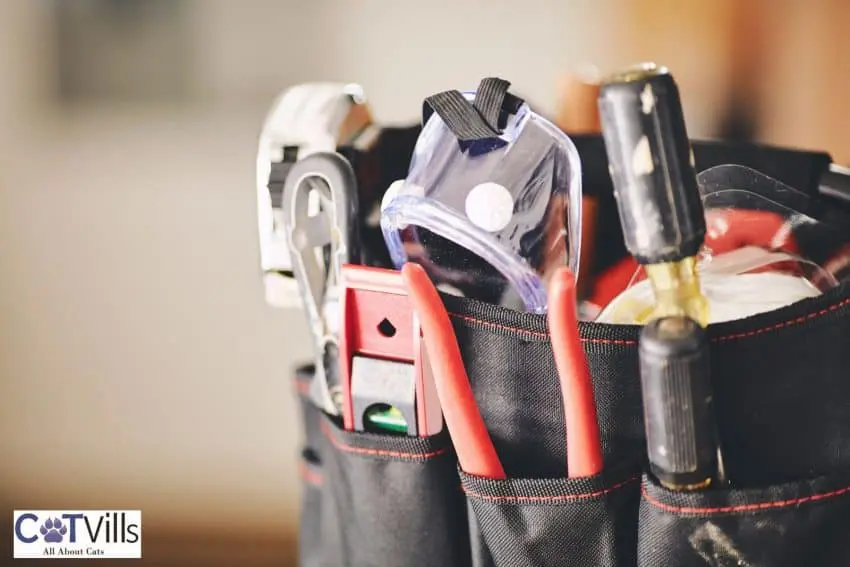
Before starting any DIY project, having the relevant tools to allow for a job well done is vital. In this specific project, you need:
- A glue gun
- Sheets of Plywood
- Safety straps
- Screwdriver and 2½-inch wood screws
- A cat-safe adhesive
- Measuring tape
- Hemp or Sisal rope
- Saw
- Dowels
- Heavy fabric
- L-shaped brackets
Luckily for you, these materials are readily available, and you could have some lying around the house or find them at the store.
2. Measure Your Cat’s Weight and Height
The vet in this video shows you how you can weigh your cat at home.
A cat tree should allow your cat to play without a fuss. You need a tree that is a couple of feet tall for a larger cat to allow climbing up the perches.
Similarly, take note of your kitty’s weight to ensure your final product weighs more than your feline companion.
A larger tree will handle whatever your cat throws at it hence it is a good investment.
3. Work on the Base Area Upwards
Most tree posts come in a variety of sizes with some having tower-like designs.
This is common in lower-priced ones since quality cat trees come at an extra cost and boast a beautiful design.
If you are on a budget, you can still get a decent tree. As is a rule of thumb, the wider a base is, the better.
A wider base gives the post a stable center of gravity, reducing the chances of toppling over.
Measure and cut a wider plywood sheet surface to set the bottom so your tree has a triangular final appearance. This means your top doesn’t spread out as far as the bottom parts.
4. Fixing the New Base
While you can remove the original base, mounting the larger base on the existing one is advisable. This mounting gives extra weight, which is recommended
You can use cat-safe glue or 2½-inch wood screws to fix this surface. However, if using base screws, screw them downwards to avoid leaving sharp bits on the upper surface.
After getting the new sturdy base, use sandpaper to smooth out the rough edges. This ensures the base is evenly smooth to allow excellent sitting and handling.
5. Examine the Post and Perches
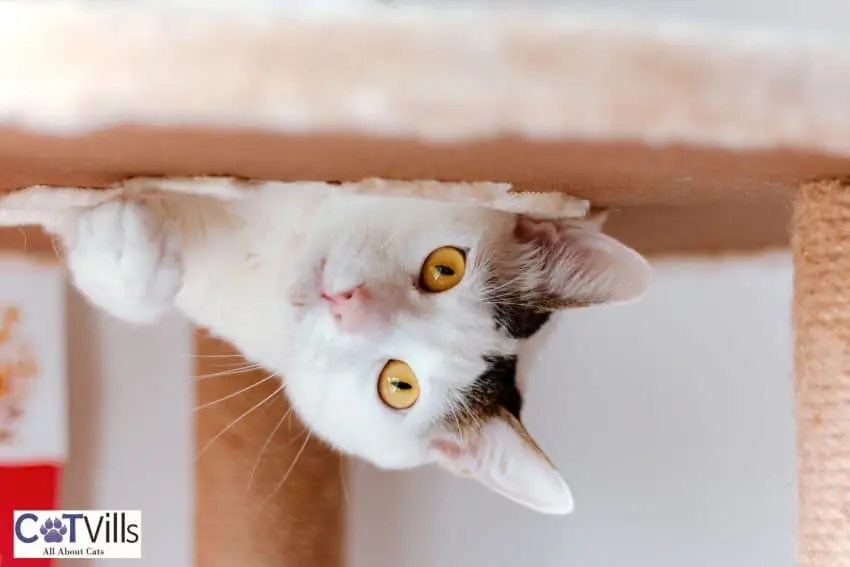
After securing the cat tree’s base, know that a wobbly post or plywood perches still leave your cat unsafe.
So you want to ensure these parts are intact using safety straps or metal brackets.
Ideally, screws offer a firm connection, and you can use a screwdriver to do this. However, it is easier to use an electric drill with the right driver bit.
6. Secure the Metal Brackets
Your cat is naturally curious, and it would not be unusual to find them scratching the metal brackets. So cover the brackets using a heavy upholstery fabric to ensure your cat stays safe.
You can also use hemp or sisal string and dowels to add more firmness. The rope gives the worn-out branches a stylistic look, while the dowels add smaller posts.
Use your cat-safe glue to hold the durable material cloth into place. A safe adhesive reduces ingestion accidents since cats can chew the glue, warranting a pet poison helpline call.
7. Test Your Work
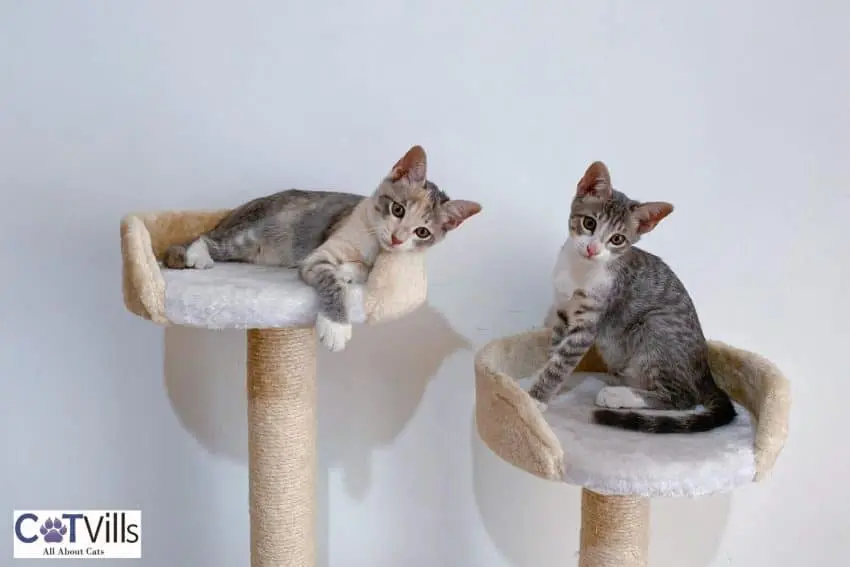
After a tedious DIY project, it is time to test out your work. You can start by examining the entire structure yourself, checking whether everything is intact.
And for the last part, have your kitty sit and play around with the tree. Ideally, have them do so in your presence so you can determine they are comfortable.
What Happens If the Cat Tree is Not Stable
An unstable kitty tree is no good just lying in the house. Here is what happens if the tree is unbalanced.
A High Rise Syndrome
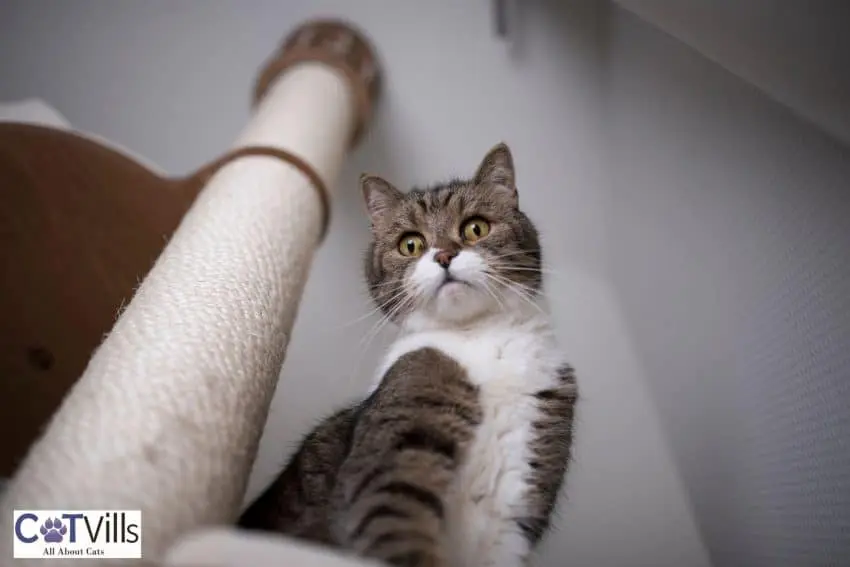
This condition happens when your cat falls from a high place.
When your cat suffers from high-rise syndrome, they will likely never want to associate with any tree post afterward.
Accidents
Your cat will likely suffer injuries or cuts when an unstable cat tree falls over.
You do not want to spend much time at the veterinary center when the situation is avoidable.
Continued House Disorganization
A cat tree with ramps offers your feline friend the chance to hop on different perches. This saves your furniture from havoc and scratches.
A Traumatic Experience
Your cat is likely to experience trauma when the tree topples over. However, you can rest assured of its safety with a stable tree.
FAQs
How Do I Entice My Cat to Use the Cat Tree?
If your cat is hesitant to use the tree post, entice them using their favorite treats or catnips. Another viable option is to have these treats hidden on the various perches so the cat can climb up to reach them.
Are Cat Trees Supposed to Wobble?
No, since this can cause severe accidents from the fall experienced. Even if it does not topple over, a slight wobble will have a negative impact on the cat’s playtime.
Where Is the Best Place to Put My Kitty’s Tree?
You can set it inside the bedroom, living space, or awkward spaces like the laundry room. Some cats love privacy, and keeping the tree hidden can be helpful, however, ensure it is close to a wall or corner.
How Do I Get Rid of the Cat Smell From the Tree?
To clean your cat furniture, use vinegar and baking soda to kill and remove the stench-causing bacteria. You can also use detergents and soap but they won’t do a perfect job. Knowing how to re carpet a cat tree might also help with this problem.
How Do You Anchor a Cat Tree to the Wall?
You can mount your pet’s tree to the wall by using study wall brackets. Fortunately, there are DIY Youtube channels which show you how to do it on a budget of less than $100.
How to Weigh Down a Cat Tree
The ultimate goal is to have a heavier base setting. So, how can you weigh down your pet’s tree? You can convert the tree’s lower part into a storage place alongside a larger base. Here, you can keep dumbbells and sandbags or use ratchet straps.
HOW DO YOU STABILIZE A CAT SCRATCHING POST?
You can put additional weight on the base to enhance stabilization. Items such as a sandbag or dumbbells, or cat food in a storage section will do the trick.
Conclusion
There you have it, cat owners, the ultimate guide on how to make a cat tree more stable.
No more does your cat have to wreak havoc on your furniture despite the presence of the tree.
With this practical step-by-step guide and available tools outlined in this article, you can be sure to do a perfect DIY project.
However, check whether your warranty stands to avoid voiding the return policy.
Comment us your thoughts now that you know how to make a cat tree more stable, you can now get rid of your cat’s worry of falling over!
Resources:
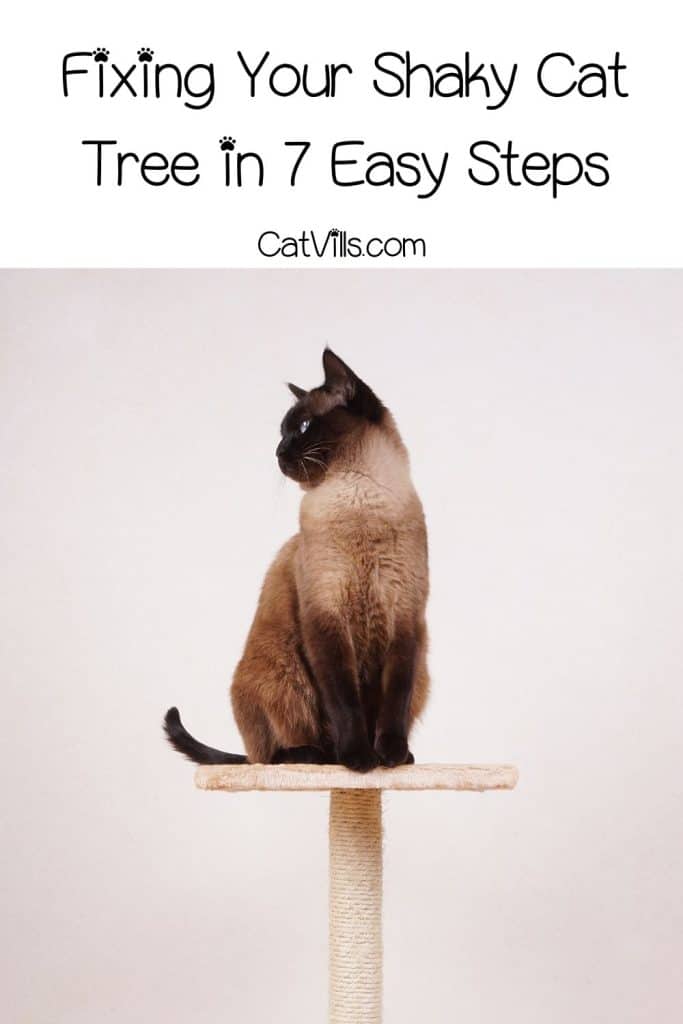

Barry Stingmore is a British content creator living in Fuerteventura, Spain. An animal lover at heart, he shares his home with a dog and four rescue cats. Barry works with the island’s animal charities to help manage and care for feral and abandoned animals. Alongside fieldwork, he works to support the charities with fundraising and raising awareness.

I have to share this with my friend. She has two Maine Coons, and they are massive. Needless to say, her tree is always on its side. LOL
These are great tips to make your tower more secure. Ours have never fallen over, luckily, but we try to buy the better ones.
What great info and so important since no one wants to see their cat fall. Thanks for sharing. Will pass it on!
Cats do tend to be wild in their play. It is a great idea to make the tree more stable.
Wow! Thanks for sharing this with us, definitely a great help. I was just thinking of making this for our cat. Now I got the reference I need.
This is such a great post! I’ve never even thought about making a cat tree more stable so this is super helpful 🙂
I would have to share this to a friend who has like 5 cats lol
She will surely love this. Great idea!
My cat is only 5 months old. We only have a small scratching post for her. I’ve been trying to keep an eye out on fb marketplace for a decent cat tower. I’ll have to remember to check it and fix it if necessary.
Glad you’re sharing these tips. This would be a helpful post for cat owners.
I have noticed that our cat trees are wobbly. It would be nice to reinforce them a little bit so they are more stable.
I love these tips, thanks for sharing your amazing tips as always.
Those are great ideas! Cats are so agile that they could easily topple over an unstable cat tree!
These are good tips. And I need to start with them!
This is all really useful advice. I think it might help us with Roxi’s cat tree. We want to make sure it’s safe for her.
I can see how cat trees can be dangerous if not stable. These are great tips on making sure your cat tree stays stationary and safe?
Our cat will definitely love his tree to be more stable. Thank you for this.
I’d like to get a tall cat tree for my cat, and will refer back to this post to make sure it is stable!
I will be sharing this post with a friend, that has a lovely cat tree for her lovely cats. I know that her concern is the stability it is for her cats.
Well this makes sense. I wonder if this is why our cat doesn’t go on her tree very often. It does wobble a little
Great tips and tricks! My cats loved their tower.
Making sure the cat tree is stable should be a priority. Great tips!
Wonderful tips! I know a few people who have cats with cat trees. I will pass this article on to them!